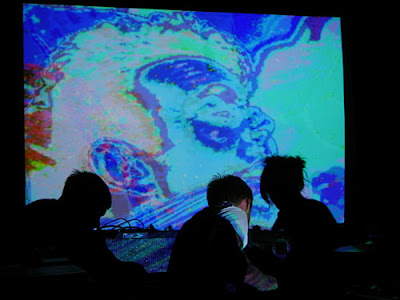The Burns Building

We stayed in Jax DeLuca's studio in downtown Buffalo with a bird named Jules. The door to his cage was always open, and the cage was next to a huge open window (on the 4th floor-- upper right corner of this photo).

We went to the famed hotbed of media arts culture straightaway. SUNY Buffalo is the place that Dr. Gerry O'Grady started the Center for Media Study in the mid-70's. He brought Paul Sharits, Hollis Frampton, Steina, Woody Vasulka, James Blue, and others together to teach in his center, which is now a "department."
How or why did Dr. O'Grady, a medieval scholar, build such a powerful center for the exploration of contemporary moving image art, and why in Buffalo? Media artist Barbara Lattanzi (UB graduate now teaching at Alfred University) informed us that he had lived in NYC for some time and was socially hooked into Warhol's Factory, and was a close follower of McLuhan, who also happened to be a medieval specialist, and who's legacy lives on in nearby Toronto, where he taught.

Here is Carl Lee, who showed us all around. Carl supports the technical infrastructure of the Department, and is a video installation artist himself. He came to Buffalo when his wife, Dorthea Braemer, took a job as the director of Squeaky Wheel.
Here's one corner of the equipment check-out room. The Department of Media Study is housed in the Center for the Arts building, along with the Department of Visual Arts. The size of Media Study is very similar to the University of Texas at San Antonio Department of Art & Art History (where I teach), only the whole place is focused on media arts, with about 350 undergrads and 40 grad students at any given time.
PBL with Jax DeLuca, Programming Director of Squeaky Wheel. I met her a couple years ago when the NAMAC conference was in Austin.

Dr. O'Grady's chair in the Squeaky microcinema room!! It's got his name on the back. When he founded the Center for Media Study at UB, he also started Media Study Buffalo-- a community media center with equipment access, classes, screenings, etc. In the early '80's a boiler blew in the building that housed it, and forced its closing. Squeaky Wheel was founded out of energy that had been generated from MSB.
The Samma Solo (on the right) is a state-of-the-art media conversion machine, hooked up to the U-matic 3/4" video deck (left). One of the major Squeaky Wheel projects is media conversion, and they are in the process of converting their archives, as well as the Hallwalls archives (which include things like Larie Anderson's first Hallwalls performance). One of the tricky parts of the process is only being able to play these old video tapes one time, because they are so delicate from age that they decompose as they are running through the system.

Jax and Jason in the media conversion room.
Finally, some pictures from the gig on saturday night of Jax' band w ((a)) ou w who warmed up the crowd for us.
Brian Milbrand on the images
 Tristan Trump on noise guitar
Tristan Trump on noise guitarJax DeLuca on the knobs.
Jim Abramson is not pictured, but played drums.

 The Colonial Theater, where we saw the Alloy Orchestra accompany Von Sternberg's film "Underworld." This would be a great room to play! Maybe next time we get to Bethlehem.
The Colonial Theater, where we saw the Alloy Orchestra accompany Von Sternberg's film "Underworld." This would be a great room to play! Maybe next time we get to Bethlehem.

 The Colonial Theater, where we saw the Alloy Orchestra accompany Von Sternberg's film "Underworld." This would be a great room to play! Maybe next time we get to Bethlehem.
The Colonial Theater, where we saw the Alloy Orchestra accompany Von Sternberg's film "Underworld." This would be a great room to play! Maybe next time we get to Bethlehem.
 At Syracuse University, Department of Transmedia chair, Heath Hanlin, begins our tour in the conference room.
At Syracuse University, Department of Transmedia chair, Heath Hanlin, begins our tour in the conference room.

































